Despite pending NHIF claims and ICT challenges, Government assures CHAK facilities of smooth transition to SHA

The Government has assured CHAK health facilities of a smooth transition to the Social Health Authority (SHA/SHIF) whose implementation will kick off in July 2024. The assurance comes in the wake of heightened engagement between CHAK facilities and NHIF to address delayed claims payments.
Delegates at the CHAK Annual Health Conference 2024 were informed that every Kenyan would be required to register afresh for SHA/SHIF. Bio metric registration would be done for all beneficiaries while every child would be registered within 14 days of birth.
The SHA/SHIF is mandated by the law to:
- Register beneficiaries
- Manage funds received under the Social Health Insurance Act 2023
- Receive all contributions
- Empanel and contract healthcare providers and healthcare facilities
- Make payments to contracted healthcare providers and healthcare facilities out of the relevant fund as provided in the Act.
According to Julia Ouko who delivered a presentation on behalf of Dr Samson Kuhora, a law on empanelment and contracting would be formulated and a body put in place to run this function. A benefits panel would review benefits after every two years in consultation with CS-Health.
The delegates were further informed that although empanelment was not guaranteed, licensed health facilities in the country would be central to the implementation of the new policy direction.
Claims management would be done through claim settling agents and medical insurance providers. A tribunal would be set up to settle disputes although any decision could be appealed in law.
Speaking at the Annual Health Conference, Mr Chrisostim Wafula, Manager, Claims Management, NHIF/SHA told representatives of CHAK health facilities and other delegates that a multi-disciplinary team has been formed to support high volume hospitals in the claims reconciliation process as the transition process continued. The reconciliations were expected to be completed by June 30 with the process coordinated from NHIF/SHA head office.
Surgical claims flagged in 2023, some of which were way above the contract rates, had already been released to NHIF branches for processing and would follow the normal payment routes while old e-claims would be released at the end of April 2024 for processing.
Further, NHIF had received money from Government and would be processing Linda Mama claims. Capitation would be paid to the health facilities in the month of May.
Some CHAK member health units confirmed that they had received NHIF payments during the third week of April. However, the facilities continued to express reservations at the slow pace of claims payments, especially given the short time period left before the start of SHA implementation.
According to the delegates, some claims had been pending for over seven years and there were cases of capitation being paid using a wrong formula. The health facility representatives termed this unfair given that the capitation was already too low for the services offered.
The challenges had further been compounded by the on-going doctors’ strike that had pushed huge numbers of patients, especially those critically ill, to the CHAK facilities, given that county health services had ground to a halt.
Further, lower level health facilities were struggling with claims and there was no guarantee they would be empaneled for SHIF due to challenges with internet connectivity. Although the Government had embarked on installation of fibre optic cables, this was mainly serving county and sub county offices and adjacent areas. Lack of internet connectivity would greatly impact Level 3 health facilities which served a large number of clients.
The CHAK member health units also expressed concern that many clients were unaware of the NHIF benefits package and called on the Government to address this shortcoming during the SHA/SHIF implementation. The delegates were informed that there was a plan to communicate the SHA/SHIF package through the division of benefits.
Further, the delegates were briefed on the referral system in the new system. Patients would be referred to Level 4 and 5 health facilities from Level 2 and 3.
The Social Health Insurance Act 2023 establishes three new funds, namely, the Primary Healthcare Fund (PHF) which will be accessed in Level 2 and 3 health facilities upon registration to SHIF, the Social Health Insurance Fund (SHIF) which will be accessed in Level 4, 5 and 6 health facilities upon registration and up to date premiums, and the Emergency, Chronic and Critical Illness Fund (ECCIF) to be accessed upon depletion of SHIF cover.
CHAK health facilities express frustration over MAKL claims handling

As Kenya moves rapidly towards actualization of radical policy changes in health, including a shift to the Social Health Insurance Fund (SHIF) by July 2024, CHAK Member Health Units have expressed profound disappointment over poor handling of medical claims by Medical Administration Kenya Limited (MAKL).
The health facilities have accused MAKL, which handles medical claims for the police, prison officers and teachers, of unfairly rejecting medical claims reimbursements, disinterest in stakeholder engagement and wanting public relations practices.
The CHAK network members expressed their deep frustration during a plenary session at the Annual Health Conference 2024. Delegates at the conference representing hospitals, health centres, dispensaries, churches, church health programmes, Medical Training Colleges and universities from 45 counties condemned MAKL for what they see as blatantly unfair practices in handling medical claims for patients treated in CHAK facilities.
Delegates shared deeply troubling experiences which they said had disadvantaged the firm’s clients as it had become difficult to continue providing services with no guarantee of claims reimbursement.
Key grievances expressed by the CHAK Member Health Units against MAKL included:
- Full payments are rarely made for services rendered. The MHUs added that even the very little money that had come through had been paid very late.
- Engagement and communication with MAKL leadership has been quite difficult. The firm does not respond to emails and calls and where a response is made, it often comes late.
- They accused MAKL of rejecting a disproportionate number of claims without plausible reasons, adding the firm seemed to have set claim rejection targets.
- It was especially difficult for the health facilities to get authorization to admit a patient despite some of the cases being emergencies.
- The requirement to refer patients through the MAKL system had proved difficult to implement.
- Different contracts for health facilities that are at the same level. The MHUs demanded uniform contracts for similar level facilities.
- MAKL has to reapprove payments after the initial approval. During the reapproval process, money is deducted and payments delayed.
- The health facilities also accused MAKL of asking for arbitrary discounts for services rendered to patients, saying this was especially difficult as reimbursed costs were already extremely low.
- Sometimes payments are signed off by MAKL and not paid.
- MAKL was also accused of declining admission extensions for very sick people, even when it was apparent such a person could not be discharged.
The CHAK members, while citing limited revenue streams, added that they were inclined to guard the little income they got jealously and called upon MAKL to improve service delivery and respect the agreements signed with the health facilities.
Pointing out that they were at the front line in health service delivery and often had to deal with disappointed and disillusioned MAKL clients, the health facilities said they were faced with the dilemma of saving a life and accepting inadequate reimbursements, which was akin to being stuck between a rock and a hard place. Out of desperation, many clients were opting to pay out of pocket despite having an insurance cover paid for by the Government.
The CHAK MHUs resolved to remain resilient and fight the unfair practices by MAKL. They were adamant that despite the challenges, being people of faith, they would embark on prayers and aggressive lobbying and advocacy to ensure their grievances were heard and addressed. They proposed a multi-tiered approach with incrementally bold steps to ensure the situation was reversed.
CHAK launches project to address presbyopia

CHAK has launched the Africa Clear Sight Partnership Project whose goal is to tackle presbyopia. According to MOH, 7.5 million Kenyans need eye care services, a number that is rapidly rising as a result of lifestyle choices and occupational hazards, among other reasons.
CHAK continues to work with other health sector players to address the vision crisis, recently launching the project at the Annual Health Conference held on April 23-25, 2024.
The project aims to increase awareness and education on presbyopia, its risk factors, associated impairment and its effects on quality of life. Together with partners, ACHAP, Restoring Vision and Africa Clear Sight Partnership, CHAK will work towards eliminating the near vision impairment.
Already, health workers from 25 Level 4 facilities, have been trained to screen for presbyopia and are expected to cascade the training to other project sites in their areas. CHAK received 100,000 reading glasses in February which continue to be distributed free-of-charge to people identified through screening to have presbyopia. CHAK expects to receive a further 100,000 pairs of reading glasses by August 2024.
What is presbyopia?
Presbyopia is when a person has difficulty focusing on near objects because of loss of flexibility in the lens of the eye. This causes up-close blurry vision and tends to occur as we get older, typically beginning at age 40.
Barriers to addressing prebyopia and other eye conditions
A low percentage of persons with presbyopia have spectacles and an even smaller percentage have spectacles that can correct presbyopia. Cost is the principal barrier to reading glasses use and this has featured in 62 per cent of respondents in different studies across sub-Saharan Africa.
Dr Michael Gichangi from MOH Ophthalmology Services Unit in his presentation at the CHAK Annual Health Conference 2024 identified the following barriers to eye care services in Kenya:
- Need not felt: Some people do not see the need to seek eye care services specially when it is not an emergency.
- Fear
- Cost
- Treatment denied by provider
- Unaware treatment is possible
- Cannot access treatment
Project implementation model
In implementing the Africa Clear Sight Partnership Project, CHAK will conduct community based and health facility based activities. At the community level, CHAK will implement an awareness, education, and screening program for presbyopia in community forums and in outreach camps. At the facility level, the program proposes to integrate screening for presbyopia at all service delivery points.
The project’s implementation approach can be summarised as follows:
- Build and strengthen the capacity of health workers to offer screening for presbyopia
- Community awareness and education
- Screening and providing high-quality reading glasses to individuals identified with presbyopia in dispensaries and health centre’s (spokes) and in hospitals (hubs)
- Support supervision
- Partnership and collaboration (MOH Eye Health Unit and Eye Health
The project which is expected to reach catchment communities around 100 CHAK member health units is being implemented in a hub and spoke model in seven regions as follows:
- Region 1: Nairobi/Central: PCEA Kikuyu Hospital as the Hub with 10 spoke health facilities
- Region 2: Eastern/Northeastern: PCEA Chogoria Hospital as the Hub with 13 spoke health facilities
- Region 3: Coast: Light House for Christ Hospital as the Hub with 4 spoke health facilities
- Region 4: Central Rift: AIC Kapsowar Hospital with 15 spoke health facilities
- Region 5: South Rift: Tenwek Mission Hospital as the Hub with 20 spoke health facilities
- Region 6: Nyanza/Western: Sabatia Eye Hospital as the hub with 23 spoke health facilities
- Region 7: Turkana: AIC Kalokol HC as the hub with 8 spoke health facilities
PCEA Kikuyu Hospital is warehousing the reading glasses and is in the process of distributing 14,000 pairs to identified presbyopia patients. Partners in Sudan and the Kenya Society for the Blind have also received reading glasses for distribution.
PCEA Kikuyu Hospital launches new Strategic Plan 2023-2028 and Vision 2050
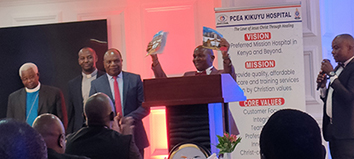
PCEA Kikuyu Hospital launched its Strategic Plan 2023-2028 and Vision 2050 in a colorful event held at Weston Hotel in Nairobi. The plan which has the theme “Customer satisfaction and innovation for sustainability” has four strategic priority areas:
- Leadership and governance
- Financial perspective
- Infrastructure improvement
- Quality healthcare
The four strategic priority areas are supported by seven strategic goals and eight strategic objectives. The Strategic Plan is expected to move the hospital forward in the next five years despite the challenging economic times. The longer term Vision 2050 was used to inform the five-year plan.
Vision 2050
A world-class mission hospital
Vision
The preferred mission hospital in Kenya and beyond.
Mission
To provide quality, affordable healthcare and training services driven by Christian values.
Board Chair Mr David Kimani acknowledged that the hospital had lagged behind in infrastructure development and modernization of equipment, adding that the plan would guide the hospital through a growth trajectory that would address these and other areas.
The plan was developed through a bottom-up approach involving the Board, management and staff of the hospital. It echoes the needs of the hospital clients and commitment of the staff to deliver high quality and affordable health care over the next five years, including respect, protection and promotion of patient rights.
In implementation of the strategy, the hospital has committed to continue working with its partners including CBM, MBF, WRF, Samaritan’s Purse, MOH, County Government of Kiambu, CMMB and CHAK to positively impact the lives of its clients and catchment community.
The hospital is currently divided into four units: General, eye, orthopedic/rehabilitation and dental. It also operates a school of nursing and a satellite clinic in Matasia, Ngong.
Focus on AIC Litein Hospital mental health conference 2023
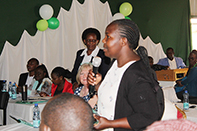
AIC Litein Hospital held its first mental health conference on October 17-19, 2023. The conference, whose theme was ‘Hope for recovery’, aimed at equipping health workers to provide quality care to mental health patients.
The three-day intensive training and information sharing forum focused on treatment of mental health patients, psychotherapy using EMDR, Christian faith integration in counseling and EMDR, strategies of self-empowerment for the unemployed client, suicide prevention an after care, national drug addiction update from NACADA, financing for mental health services, in addition to other topics.
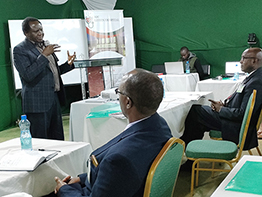
CHAK General Secretary Dr Mwenda
speaking during the AIC
Litein Mental Health Conference.
Financing mental health services
CHAK General Secretary Dr Samuel Mwenda gave the participants an overview of national policy changes in the run-up to the launch of Universal Health Coverage (UHC) Programme by President William Ruto during Mashujaa Day celebrations on October 20, 2023. The President launched the national UHC programme at the Wilson Kiprugut Chumo in Kericho County. Dr Mwenda expressed confidence that mental health services would be covered by the social insurance fund expected to be used by all Kenyans.
Treatment of mental health conditions
Participants were taken through theory and practical sessions on medical treatment of different mental conditions. The sessions covered various psychiatric disorders, examination, diagnosis, treatment, prognosis, diagnostic and therapeutic challenges.
Eye movement desensitization and reprocessing (EMDR)
Theory and practical EMDR training sessions featured through out the conference. Participants were taken through creating a safe place, water bath technique, principles of brain habit changes, among other EMDR techniques. Live and video demos of practical EMDR sessions were used to enhance learning and participants given an opportunity to practice the newly learned technique.
Empowerment in unemployment
During this session that examined the effects of unemployment on mental health, participants were also taken through strategies for empowerment in the face of the current difficult economic times.
Among the strategies identified were:
- Use of labor-intensive technology
- Accelerating investment in agriculture
- Diversification of healthcare
- Services and employment growth
Suicide prevention
During the session on suicide prevention, participants heard that 90 per cent of individuals who commit suicide have visited a health facility within the last one year. Health workers therefore needed to be alert to signs of suicide, including verbalizing such an intent, withdrawal and isolation, increased use of alcohol and drugs, among others. Where such signs and symptoms were identified, the health workers were asked to take the necessary treatment measures.
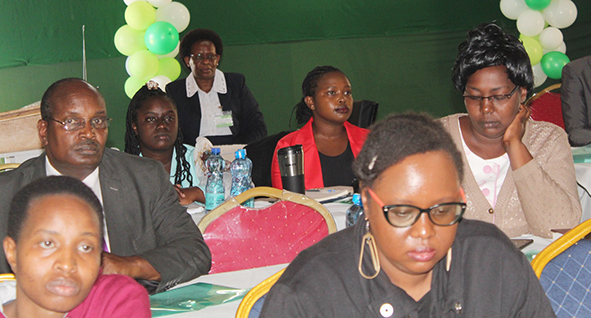
Participants listen keenly to presentations at the conference.
National drug addiction trends
NACADA prevention coordinator Wendy Waithaka updated the conference participants on national drug and alcohol addiction trends. Both children and adults were affected by drugs and alcohol.
In Kenya over 39 per cent of deaths annually result from NCDs and more than 50 per cent hospital admissions are due to NCDs (MoH, 2020). Major risk factors for NCDs are:
1. Harmful use of alcohol
2. Tobacco use
3. Unhealthy diets
4. Physical inactivity
The Kenyan National Commission of Human Rights estimates that 25 per cent and 40 per cent of outpatients and inpatients suffer from mental health. The most frequent diagnoses of mental illnesses made in general hospital are depression, substance abuse, stress, and anxiety disorders.
The National Survey on the Status of Drugs and Substances of Use in Kenya, 2022, identified the following new and emerging drug trends:
1. Smokeless tobacco – snuff, tamboo and ndovu ( kuber forms), nicotine pouches
2. Electronic delivery systems – shisha pens, e-cigs, vapes
3. Cannabis edibles – cookies, “mabuyu”, candies
Lowest age for initiation to drugs and alcohol was as follows:
- Tobacco – 6 years
- Alcohol – 7 years
- Cannabis – 8 years
- Khat – 9 years
- Prescription drugs – 8 years
- Heroin – 18 years
- Cocaine – 20 years
CHAK and MHUs mental health programmes
CHAK MHUs were given an opportunity to speak on their mental health programmes. It was a moment of pride as Tenwek Hospital, PCEA Kikuyu, AIC Litein, PCEA Chogoria, AIC Kapsowar, among other CHAK members spoke on their efforts towards the mental health of their clients. Mental health programmes in CHAK health facilities have grown tremendously over the last five years. Most of the health facilities now include a mental health counsellor in their ward rounds.
In the recently launched CHAK Strategic Plan 2023-2028, mental health is domiciled in the NCDs programme.
CHAK HIV/AIDS programmes positively impacting communities
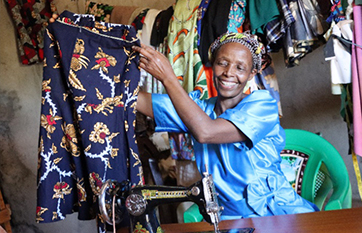
Expanding access to HIV prevention, care and treatment services
CHAK’s two main HIV/AIDS projects, USAID Jamii Tekelezi and CHAP Stawisha, are designed to accelerate progress towards HIV epidemic control. USAID Jamii Tekelezi project supports 200 health facilities in Meru, Nyandarua, Tharaka Nithi and Embu counties, while CHAP Stawisha supports 38 facilities spread across the eight counties of Embu, Meru, Laikipia, Tharaka Nithi, Machakos, Makueni, Kitui and Nyandarua.
These projects implement comprehensive HIV prevention, care, and treatment services in collaboration with CHAK member health units, county governments and other implementing partners. Together the CHAK HIV projects support over 92,750 persons living with HIV (PLHIV) on life-saving antiretroviral therapy (ART).
All programmatic interventions are aligned to the national HIV Prevention and Treatment Guidelines. As part of sustainability and transition, CHAK implementation is anchored on a county-owned, county-led, county-managed HIV service delivery strategy that emphasizes coordination, integration, and collaboration.
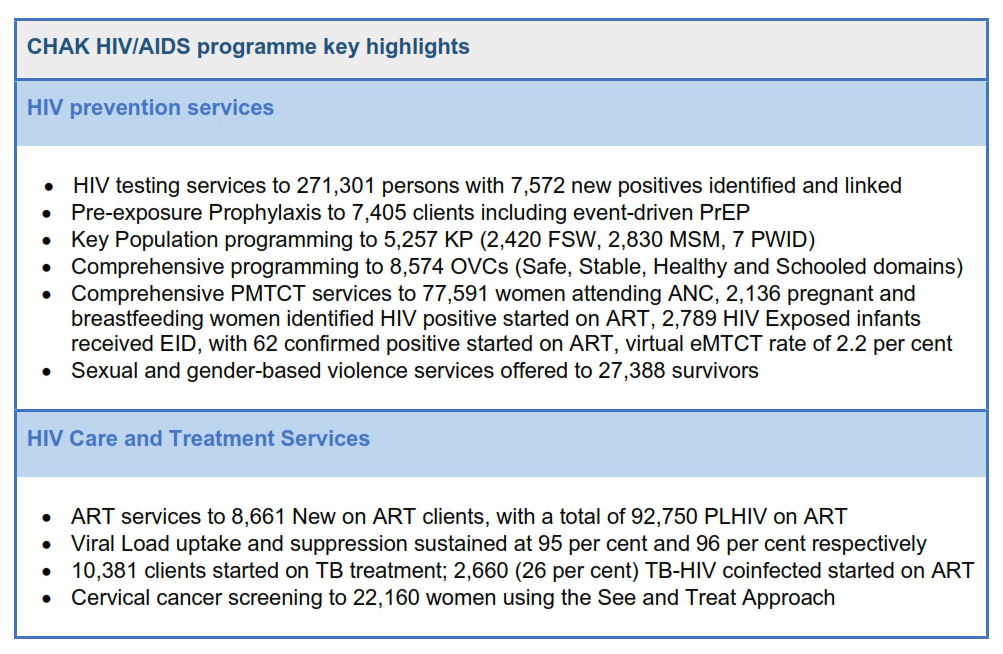
CHAK HIV projects partner with respective county governments through Memoranda of Understanding (MOU). These create an enabling environment for integrated service delivery, mainstreaming of HIV services into primary health care, and stimulate a sense of ownership that fosters incremental transfer of service delivery functions to the counties.
Crucial program interventions included scale up of differentiated service delivery (DSD). Adolescent girls and young women (AGYW) and men are targeted with HIV self-testing, index testing, social network services (SNS), PrEP, and intimate partner violence (IPV) screening.
Women of reproductive age (WRA) are provided with integrated HIV and family planning services that also incorporate cervical cancer screening and treatment. The key populations (KP) are reached through involvement of KP-led civil society organizations and peer snowballing. To improve continuity of treatment, fast-track (a form of DSD) and community ART models are deployed, with over 80 per cent of the treatment cohort receiving multi-month ART prescriptions. Adolescents and young persons are targeted with intensified psychosocial and adherence support such as operation triple zero (OTZ) with demonstrable sustained improvements in viral suppression from 72 per cent at OTZ baseline to 89 per cent.
In leadership and governance, CHAK supports the Faith Sector Working Group stakeholder coordination, with engagement of the Council of Governors and the Office of the President towards integrated, stronger, and resilient systems in faith-based implementing mechanisms.
Enhanced economic resilience, caregiving, and protection capacity of households and caregivers – USAID Jamii Tekelezi OVC
Kenya’s population is estimated to be 47.5M, with 67 per cent aged 29 years and below. Children in Kenya total 19 million, of who 40 per cent are below 14 years. An estimated 2.8 million children in Kenya are orphans and over 0.5 million of this population are orphaned due to the HIV epidemic. The 2019 Kenya Population and Housing Census estimated the population of Orphans and Vulnerable Children (OVC) aged 0 – 17 years in Meru County to be 12,124. Children orphaned due to HIV are often considered more vulnerable as they face high rates of poverty, disease, stigma and discrimination, gender-based violence and abandonment.
|
|
|
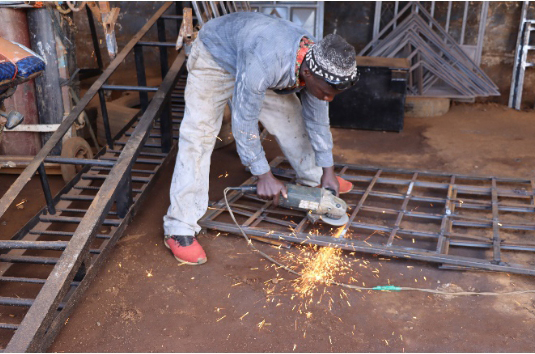 |
Photos:
(Left) A caregiver and Household Economic Strengthening (HES) beneficiary displays a sample of her work; (Centre) A trainee and beneficiary of the apprenticeship program with his trainer repairing a vehicle at a garage in Meru; (Right) A beneficiary showcases his skills in welding while making a window for a customer.
CHAK through its USAID Jamii Tekelezi program implements a Household Economic Strengthening (HES) and apprenticeship initiative in Meru County as part of its OVC program.
This initiative aims to improve the economic resilience and stability of caregivers and the children under their care to prevent and mitigate the impact of HIV/AIDS on PLHIV together with their families, and in particular, the financial hardships occasioned by caring for someone with HIV.
In Meru County, USAID Jamii Tekelezi program supports 3,456 OVC of who 1,388 are Children & Adolescents Living with HIV (CALHIV).
One of the strategies employed under the HES initiative is provision of business start-up kits for various income generating activities. Between January and June 2023, USAID Jamii Tekelezi Project supported 30 households with business start-up kits. A total of 26 out of the 30 households have shown improvement measured through increase in business stock and improved household income that has enabled them to cater for their basic needs.
Apart from the business start-up kits, USAID Jamii Tekelezi has rolled out an apprenticeship program to empower eligible OVC with vocational skills to better position them in the labour market as well as allow them to exploit business opportunities. By June 2023, 13 OVC had been placed in various apprenticeship training programs. These OVC are attached to local entrepreneurs and mentors willing to take them through basic training in vocations such as motor vehicle repair, driving, welding, electrical wiring, and hairdressing. Acquisition of these skills will improve their households’ economic prospects and enhance their resilience to thrive amid tough economic times. To achieve this, USAID Jamii Tekelezi collaborates with the County Departments of Health, Directorate of Children Services, the Registrar of Births, local administration, Department of Social Services among other partners.
Expanding access to family planning services through community level interventions

CHAK implemented the ACHAP Afya project in five sub-counties in Kilifi County from July 2020 to July 2023. The project’s goal was to reduce maternal and child morbidity and mortality in Kenya and Uganda. To increase uptake of family planning (FP), the project engaged and empowered community-based distributors of FP methods to reach clients at household level.
A total of 19 Community Health Assistants (CHAs) were trained as Community Based Distributors to provide family planning commodities to underserved and hard to reach populations. To address the unmet need for family planning in the project area, ACHAP Afya expanded access to FP method mix at community level and engaged in commodity advocacy at the county level through Technical Working Groups. The Sub County Health Management Team supported the community-based distributors of FP with commodities, support supervision and mentorship.
For social behavior change leading to demand creation for FP services, the project worked with religious leaders, young people and community resource persons who encouraged women of reproductive age to take up family planning.
Esther Rua is a Community Health Assistant (CHA) who worked with the ACHAP Afya project as a family planning Community Based Distributor (CBD) in Ganze Sub-County.
To ensure the family planning needs of each household under her care were met, she worked closely with the Community Health Volunteers (CHVs) under her supervision.
The CHVs counselled family members eligible for family planning during their monthly household visits and then informed her when any of the people counselled chose a method. She would give the method to the client during the next support supervision visit with the CHVs. She says the CHVs have been effective mobilisers and the uptake of family planning in her community has been on an upward trend.
According to Jackline Ngala who also worked as a CHA and FP CBD in Ganze Sub-County, community forums such as chiefs’ barazas, outreaches, women’s group meetings and community dialogue days provide valuable opportunities to take the FP message to both men and women.
Teenage pregnancies are common in Kilifi County. According to KDHS 2014, the teenage pregnancy rate stood at 21.8 per cent against a national average of 18.1 per cent. Jackline adds that for teenagers 15-17 years old who cannot make decisions on family planning uptake, it is crucial to involve the parents.
Many parents with teenage girls allowed their children to take up a family planning method as counselling on abstinence had not been effective in preventing teenage sex. However, there are parents who felt that allowing teenagers to take up family planning allowed them to have careless sex.
Jackline, together with the CHVs under her supervision, held meetings with the teenagers monthly to advocate for abstinence, safe sex and family planning.
“We avoid giving hormonal FP methods to teenagers although many parents prefer Implano as it lasts the whole school term,” she adds.
Regina Muli, a CHA and FP CBD working in Kilifi South Sub-County, reached teenagers affected by early pregnancies through maternal child health clinics. When the teenagers visited the clinic with their babies, she would invite them for a chat on family planning.
“Many teenagers did not have the right information about family planning and after counseling, they were able to choose a method with the consent of their parents where applicable,” said Regina.
William Zoka, a community health assistant working in Kaloleni sub-county added that they integrated family planning services in mother-to-mother support groups and outreaches.
To reach more men, Zoka says he conducted community health dialogues targeting them. He also did health talks in the health facility during morning hours when clients came for services. Additionally, he was able to reach the men in entertainment joints and other places where they congregated.
ACHAP Afya supported the community-based family planning distributors with training, support supervision and data quality audits.
Page 1 of 2












